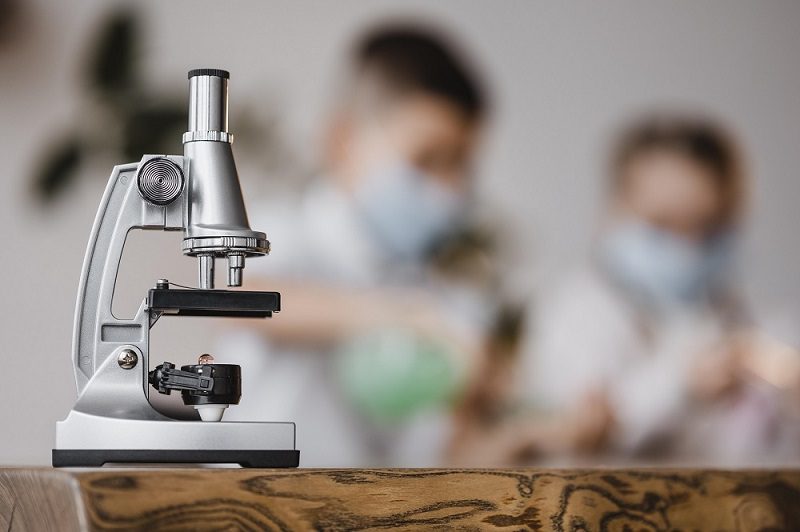Introduction
Lawrence Berkeley National Labs just turned on a $27 million electron microscope. Its ability to make images to a resolution of half the width of a hydrogen atom makes it the world’s most powerful microscope.
The following KQED production was produced in high definition.
What could be more human than the desire to decode the mysteries of the world around us? In this pursuit, we’ve pointed our devices not only to the heavens above, but also to the smallest things below.
If you want a sense of how far we’ve come in our yearning to see the invisible, a good place to start is the Golub Collection, nearly 100 antique microscopes from the 17th, 18th, and 19th centuries housed at the University of California, Berkeley.
Steven ruzin
Steven ruzin (Curator,The Golub collection,UK Berkeley) says-“They’re beautiful. They are hand made. They’re really individual microscopes. They were covered in vellum or they’re covered in fish skin. They were hand stamped with gold leaf.
When microscopes were first invented, they looked at anything and everything. They looked at bugs. Looked at plants. They looked at one of the favorite things was pond scum. One of the things that the microscopists looked at were sperm cells. And they realized that sperm cells had something to do with reproduction. And so they imagined little curled up people inside of them.”
Early microscopes led 17th century scientists, like Englishman Robert Hooke to important discoveries, like the cell. But these unsophisticated devices couldn’t save early researchers from reaching some hilarious conclusions.In the 300 years since, the size of what scientists can see has shrunk considerably from tiny animals to individual cells to chromosomes.
And now as of January of 2021 at the Lawrence Berkeley National Laboratory, researchers are actually able to count individual atoms, even the smallest ones.
Welcome to the world’s most powerful microscope. This Department of Energy electron microscope cost $27 million. It can view objects twice as small as the last generation of the world’s most powerful microscopes.
Ulrich Dahman
Ulrich Dahman (Director, Nat’l center for electron microscope) says – “It’s a big beast in a big box. Everybody was worried that somehow it would be droped or it wouldn’t quite fit in through the side of the building. So it took all day to get this machine in here. It was hoisted up into its own room on a crane. And its power cable is as thick as a fire hose. 300,000 volts goes up into the gun. The electrons are accelerate and that gets them up to near the speed of light.”
At that speed, the electrons behave like waves with very short wavelengths. An electron microscope can make images of much smaller things than a light microscope because electrons have much shorter wavelengths than light.
The walls of the National Center for Electron Microscopy are decorating with photos of the materials that have been image there. It’s a view into the nano world where things are hundreds of thousands of times smaller than the width of a hair.
Ulrich Dahman says
Ulrich Dahman says-“This is actually our best image. This is the best that this microscope can do now. It’s a sheet of carbon atoms that is just one atom thick. It’s the thinnest non object you can make.
Each one of these atoms is bond very strongly to its nearest neighbors and they form this hexagonal honeycomb structure. This is your starting focus? You’re just setting the starting focus now? Something like that.”
Learn more about laboratory equipment

This sheet of carbon atoms might one day replace silicon to make computers dramatically faster and smaller. Other materials Dahman and his colleagues are studying also hold great promise.
The aluminum alloy they’re looking at today could one day be use to build a spaceship to Mars. In the past, aluminum alloys have suffered catastrophic failures brought on by tiny atomic wrinkles that spread through the aluminum and caused cracking.
That’s why researchers are continuously in search for combinations of metals to mix in with the aluminum. These clumps of metals, called precipitates, serve as a barrier against cracking.
Ulrich Dahman
Ulrich Dahman says-“So this one here is aluminum. And this one here is a precipitate. We know these are the copper atoms here. That is quite clear. And everybody agrees. But there’s some controversy on whether this is aluminum and that is magnesium or whether this is magnesium and that is aluminum. And basically, that’s what we want to find out. It’s very delicate.”
Figuring out the precipitate’s precise atomic structure is essential in order to later test its strength.
“So one of the most important things in all of this to get the sample into the right orientation so that you’re looking down a row of atoms. And it can’t be tilted. If the row of atoms is slightly tilted, then you’ll wash out the resolution. And see what we have. Promising. The orientation looks good.”
Surprisingly, the basic structure of this microscope hearkens back to the 18th century.
Steven ruzin
Steven ruzin says – “This microscope is functionally identical to an electron microscope. It has a light source. An electron microscope has an electron source, which is a filament.
It has a condenser system, which would condense the dispersed rays of light or to disperse electrons from the filament of the electron microscope down into the column and onto the sample. And in our case here, the light is condense through this lens and is transmitte through the sample, just like an electron microscope.
This microscope has an objective lens here, the primary magnification lens. An electron lens has the same thing. The difference, of course, is that for an electron microscope the lenses are magnetic fields and electromagnets. And in a light microscope like this here, the lenses are, of course, made out of glass. But they both cause a bending or a refraction of the rays or the electrons, whatever the case may be.”
But unfortunately, the bending light rays or electron beams that magnify an object also can make two objects difficult to distinguish from each other. The phenomenon that causes this blurring is call spherical aberration.

Steven ruzin says
Steven ruzin says – “It has to do with the rays of light that travel through the middle versus the rays of light that travel through the edges of a spherical surface of a lens, focusing it at two different or multiple points in the image plane up in the body. That multiple focus point of the light going through the objective decreases resolution and makes a blurry image.”
An electron microscope corrects spherical aberration by using magnetic fields to bend the electron beams. And that requires a very stable electrical current.
Ulrich Dahman
Ulrich Dahman says – “So in this rack here, we have the power supplies for the correctors. So each of these power supplies has a very high stability, very modern electronic system.”
Overcoming spherical aberration is what has made the Berkeley microscope’s incredible atomic resolution possible. And that’s where it gets its name. The device is call the TEAM microscope, which stands for Transmission Electron Aberration-Corrected microscope.
“ I think we are close. This is a [INAUDIBLE] magnesium should be in this position here and in this position here. And this should be aluminum here. It looks pretty promising to me.”
Conclusion
Even so, this microscope isn’t perfect. In October of 2009, the center will unveil the next version of the TEAM, which will allow scientists to put their materials under stresses, like heat or pressure and watch the results in real time.
Steven ruzin says – “The human need is the need to understand the physical world, to understand where we are and what we’re doing and how it exists back at the beginning of microscopy. They did the best they could. But they could see a limited amount. And invention– that’s what humans do is they invent things and they make machines better and more versatile.”
Learn more about this machine click the link






I do enjoy the manner in which you have presented this particular matter and it does give me some fodder for thought. On the other hand, through what precisely I have experienced, I basically hope when other responses pack on that people stay on issue and in no way start on a tirade associated with the news du jour. All the same, thank you for this fantastic piece and although I do not really go along with it in totality, I value your standpoint.
But a smiling visitor here to share the love (:, btw great layout. “Make the most of your regrets… . To regret deeply is to live afresh.” by Henry David Thoreau.
At this time it seems like Drupal is the best blogging platform out there right now. (from what I’ve read) Is that what you’re using on your blog?
I don’t think the title of your article matches the content lol. Just kidding, mainly because I had some doubts after reading the article.
I don’t think the title of your article matches the content lol. Just kidding, mainly because I had some doubts after reading the article.
Thanks for sharing. I read many of your blog posts, cool, your blog is very good.
Your point of view caught my eye and was very interesting. Thanks. I have a question for you.
Your point of view caught my eye and was very interesting. Thanks. I have a question for you.
Your point of view caught my eye and was very interesting. Thanks. I have a question for you.
Your article helped me a lot, is there any more related content? Thanks!
Your point of view caught my eye and was very interesting. Thanks. I have a question for you.
You really make it appear really easy together with your presentation however I in finding this topic to be really one thing which I feel I would by no means understand. It sort of feels too complicated and very huge for me. I am looking ahead for your next publish, I’ll attempt to get the hang of it!
hello there and thank you for your information – I’ve certainly picked up anything new from right here. I did however expertise some technical points using this website, as I experienced to reload the web site a lot of times previous to I could get it to load correctly. I had been wondering if your web hosting is OK? Not that I’m complaining, but slow loading instances times will very frequently affect your placement in google and can damage your quality score if advertising and marketing with Adwords. Anyway I’m adding this RSS to my email and could look out for a lot more of your respective interesting content. Ensure that you update this again soon..
It?¦s really a cool and helpful piece of info. I?¦m happy that you simply shared this helpful info with us. Please stay us up to date like this. Thanks for sharing.
I love your blog.. very nice colors & theme. Did you create this website yourself? Plz reply back as I’m looking to create my own blog and would like to know wheere u got this from. thanks
Thanks for sharing. I read many of your blog posts, cool, your blog is very good.
Joy to read and contagious enthusiasm? I thought I was immune, but you proved me wrong.
You are a very bright person!
Bookmarking this for future reference, because who knows when I’ll need a reminder of The wisdom?
I will immediately grab your rss as I can not find your e-mail subscription link or newsletter service. Do you’ve any? Please let me know in order that I could subscribe. Thanks.
The piece was both informative and thought-provoking, like a deep conversation that lingers into the night.
The creativity and intelligence shine through, blinding almost, but I’ll keep my sunglasses handy.
The Writing is like a lighthouse for my curiosity, guiding me through the fog of information.
I don’t think the title of your article matches the content lol. Just kidding, mainly because I had some doubts after reading the article.
I am extremely inspired along with your writing skills as neatly as with the
structure to your weblog. Is this a paid topic or did you customize it your self?
Either way keep up the excellent quality writing, it’s uncommon to peer a nice weblog like this one these
days.
Thanks for sharing. I read many of your blog posts, cool, your blog is very good.
Your article helped me a lot, is there any more related content? Thanks!
Your article helped me a lot, is there any more related content? Thanks!
I’ve been browsing online more than 3 hours as of late, yet I never found any attention-grabbing article like yours. It’s lovely worth sufficient for me. Personally, if all web owners and bloggers made just right content as you did, the internet might be a lot more helpful than ever before. “When you are content to be simply yourself and don’t compare or compete, everybody will respect you.” by Lao Tzu.